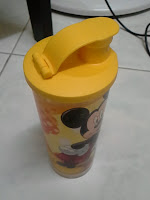Thermoplastic type:
A type of plastic which can be melt by heat and be molded. Common examples are PVC, Polyethylene, Acrylic and Polystyrene. There are plastic that can be reshape after melt-down and become other product.
PVC:Stand for Polyvinyl chloride. It is hard and lightweight plastic. Soften at 80 degree Celsius.
PVC comes in many form, in which they will have different characteristic for different purpose.Plasticized PVC is used for flexible applications such as insulating - cables. Phthalate is added to PVC to become Plasticized PVC( PPVC ), the rigid PVC will hen ce become flexible to used as flexible pipe or insulating cable. uPVC also known as rigid PVC, is PVC without adding Phthalate, so it remains hard and cannot be bend,it is strong against sunlight, chemical and oxidation of water. uPVC is stabilized for outside use ( construction usage ) and is used for plastic windows and plastic pipes( hard ). PVC is also being chlorinated to increase its chlorine content, CPVC also known as chlorinated PVC has higher heat stability than normal PVC, it is frequently used in hot water pipe.
Characteristic:
uPVC: hard, not flexible, insulator, low heat stability, strong resisitance against chemical, sunlight
PPVC: flexible, insulator, low heat stability
CPVC: higher heat stability
E,g of product: pipes, insulator cable
Acrylic:
Acrylics are available in a range of colors and can be opaque, translucent or transparent. They are available in sheet, rod, and tube for use in injection molding extrusion and vacuum forming. Acrylics withstand weather and are stable in sunlight. Almost any color can be produced. Transparent acrylic can be as clear as the finest optical glass, this led them to be used in optical equipment such as cameras. It is possible to significantly strengthen the acrylic when it is being made, these high grade acrylics are used use for aircraft windows. ( resource: http://www.the-warren.org/GCSERevision/resistantmaterials/plastics.html )
Characteristic:
-Color Variation
-Strong, Hard
-Less flexible
-Withstand weather
-Transparent, Opaque
E.g of product: Cars window, aircraft window
Polyethylene:
Polyethylene product is mass produce every day in our life. The range can be traced from food packaging to gas pipe. It is strong against many kind of chemical, so it is well known as a material for chemical container like shampoo bottle. Polythene can be processed to become many form, the common form is PET, HDPE and LDPE. PET: Polyethylene Terephthalate. It is a clear, tough and solvent resistance plastic with a resin identification code of 1. The best example for a PET plastic product is mineral water bottle.
HDPE: High-density Polyethylene. It is a hard to semi-flexible plastic, resistance to chemical, has a waxy surface and opaque in appearance with a resin identification code of 2. The best example is a shampoo bottle.
LDPE: Low-density Polyethylene. It is soft, translucent, flexible, and easily scratch and melts. It is coded with the resin identification code of 4. The best example of LDPE plastic is garbage bag.
Polypropylene:
PP is hard, rigid but still has bit flexibility. It is translucent and has a waxy surface. It withstands solvent and also has great heat stability as it is a best example of material for a Tupperware bottle. Its resin identification code is 5.RESIN IDENTIFICATION CODE:
Resource from: http://www.docstoc.com/docs/72649119/THE-PLASTIC-IDENTIFICATION-CODE
Example of plastic product:
Type: LDPE
Type: PVC




No comments:
Post a Comment